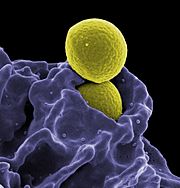Immunology facts for kids

A bacterium (MRSA, yellow) being eaten by an immune cell (Neutrophil, purple).
|
|
| System | Immune |
|---|---|
| Subdivisions |
|
| Significant diseases |
|
| Significant tests |
|
| Specialist | Immunologist |
Immunology is the study of the immune system. This amazing system is like your body's personal army. It works hard to protect you from things that can make you sick. These include infections from bacteria, viruses, and other tiny living things.
Immunology explores how your immune system works when you are healthy. It also looks at what happens when the system doesn't work right. Scientists have found that all plants and animals have some form of an immune system.
One basic type is called innate immunity. This is the protection you are born with. It uses special sensors, like toll-like receptors, to spot harmful invaders. When these sensors find something like bacteria, they kick off an immune response. This type of immunity is always ready to go.
Vertebrates, which are animals with backbones (like humans, fish, and birds), have a second, more advanced type of immunity. This is called adaptive immunity. It's special because it can "remember" past infections. If you get sick with the same thing again, your adaptive immune system reacts much faster and stronger. This memory helps vertebrates survive in a world full of germs.
Contents
How Vaccines Boost Your Immune System
Vaccines are a clever way to help your body's adaptive immune system. They give your body a safe, weak version of a germ. This lets your immune system practice fighting it off.
Your body then "remembers" how to deal with that specific germ. If you later come across the real, strong germ, your body is ready. It can fight it off quickly before you get seriously sick. This is why vaccines are so important for public health.
When the Immune System Makes Mistakes
Sometimes, the immune system can cause problems. In autoimmune diseases, the body accidentally attacks its own healthy parts. It mistakes them for foreign invaders. For example, some types of arthritis happen this way.
Another challenge is when germs hide from the immune system. Viruses, for instance, can sneak into your cells. Once inside, they take over the cell's machinery. HIV is a virus that attacks key immune cells. This can weaken the body's defenses. Scientists work hard to find ways to help the immune system fight these tricky invaders.
A Look at Immunology History
The study of immunology has a long and interesting past. People noticed immunity even in ancient times. Around 430 BC, during the plague of Athens, it was observed that people who had recovered from the sickness could care for the sick without getting ill again.
In the 18th century, scientists like Pierre-Louis Moreau de Maupertuis did experiments. He saw that some animals were naturally immune to scorpion venom. These observations helped lead to major discoveries.
Louis Pasteur (1822–1895) was a key figure. He developed vaccination and the germ theory of disease. This theory said that tiny living things, or germs, cause diseases. This was a big change from older ideas.
Later, Robert Koch (1843–1910) proved that microorganisms cause infectious disease. He won a Nobel Prize for his work. In 1901, the yellow fever virus was discovered, confirming viruses as human pathogens.
The late 1800s saw huge progress in immunology. Scientists learned a lot about how the body fights off disease. Paul Ehrlich (1854–1915) and Ilya Mechnikov (1845–1916) shared a Nobel Prize in 1908. Ehrlich studied how the body's defenses specifically target invaders. Mechnikov focused on how certain cells "eat" germs.
Even bacteria have a simple immune system. They have a DNA restriction system. This helps them fight off bacteriophages, which are viruses that infect bacteria.
Related pages
Images for kids
-
Artist's impression of monocytes, a type of white blood cell.
See also
 In Spanish: Inmunología para niños
In Spanish: Inmunología para niños


